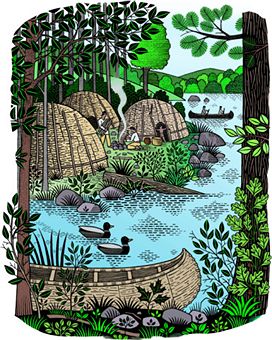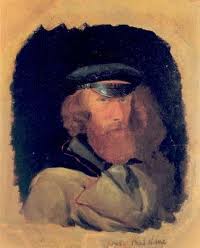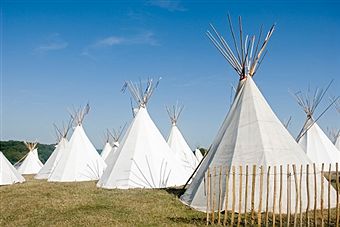پل کین، هنرمند خط شکن
Paul Kane, Frontier Artist
Since Christopher Columbus first met American Indians in 1492, many Europeans had been fascinated by Indian life and culture. As a result, there was a demand in Europe for drawings and paintings of Native Americans. European artists who had never seen an Indian supplied most of this demand. But in the nineteenth century, several painters traveled into Indian Territory to make an authentic record of native life. One of the first artists to do this was the American painter George Catlin. In 1841, Catlin published a book of his work. Catlin’s work helped inspire another important frontier artist, the Canadian Paul Kane.
Paul Kane was born in Ireland in 1810. His family moved to Toronto, Ontario, Canada, when Paul was nine years old. The young boy was not very interested in school. At that time, there were still Indians living in wigwams in the Toronto area. Young Paul liked visiting the Indian village instead of going to school.
Since Paul spent little time in school, he was largely a self-taught artist. He also became a surprisingly good writer, considering that he had not spent much time studying spelling or grammar. After working some years making and decorating furniture, Kane was ready to travel. He spent the years from 1836 to 1841 living and traveling in the United States. Then he traveled in Europe from 1841 to 1843, studying the great painters of the past. He was back in the U.S.A. until 1845, and then he returned to Toronto. Immediately upon his return, Kane headed into the wilderness areas around Georgian Bay, Sault Ste. Marie, and Lake Michigan. His plan was to sketch Indian life before it disappeared forever. American Indians were dying so rapidly from European diseases, such as measles and smallpox, that many people believed that they would soon vanish as a race. Their culture was threatened too. As white settlers demanded more land, Indians were being herded into small pieces of land called “reservations.” Here they could no longer practice their traditional way of life. Kane wanted to capture Native American life while it still existed.
Kane returned to Toronto at the end of 1845. He had received one good piece of advice and that was if he wanted to travel into the wilderness, he would have to go with experienced people. He was able to get the support of the Governor of the Hudson’s Bay Company, Sir George Simpson. In May 1846, Kane joined the annual canoe fleet of fur traders going west. Kane would travel all through the wilderness areas of western Canada and northwestern U.S.A. During this time, he made hundreds of sketches of Indian life.
Although Kane faced incredible hardships during his travels, he was able to see what he wanted to see. He was able to take part in one of the last great Buffalo hunts and killed two large bison himself. Traveling west with the fur traders he visited many forts and trading posts. He saw and painted a prairie fire. He shot a grizzly bear at close range and killed several wolves that attacked his horses. He learned to travel long distances on snowshoes in winter. Finally, he arrived at the Pacific coast, where he made some fine drawings of the west coast Indians.
European diseases had reached there just before Kane. Fifteen hundred Indians had died near Fort Vancouver in the summer of 1848. One wealthy chief had ruled 1,000 warriors and had ten wives, four children and eighteen slaves. Now he had only one wife, one child and two slaves. Kane had not come too soon. However, there were tribes still unaffected by western culture and western diseases. Kane also traveled widely around the Columbia River in northwestern U.S.A. Everywhere he went, he sketched Indian chiefs and scenes of native life. On his return trip, he encountered a large war party of 1,500 braves on the warpath against their traditional enemies. He was able to sketch the leading chief, Big Snake, who was later killed in single combat during the battle.
When he arrived back in Toronto, Kane gave an exhibit of his sketches and watercolors. Most of the rest of his life was spent turning these drawings into finished paintings.
inspire
to give someone the idea for something, especially a story, painting, poem etc
The story was inspired by a chance meeting with an old Russian duke.
a range of designs inspired by wild flowers
—
wigwam
a structure with a round or pointed roof used as a home by some Native American tribes in the past
—
wilderness
a large area of land that has never been developed or farmed
the Alaskan wilderness
—
sketch
a simple, quickly-made drawing that does not show much detail
sketch of
Cantor drew a rough sketch of his apartment on a napkin.
—
measles
an infectious illness in which you have a fever and small red spots on your face and body.
People often have measles when they are children.
ᅳsee also German measles
—
smallpox
a serious disease that causes spots which leave marks on your skin
—
herd
to bring people together in a large group, especially roughly
The prisoners were herded together .
I don’t want to be herded around with a lot of tourists.
herd somebody into something
The visitors were herded into two large halls.
—
fleet
a group of ships, or all the ships in a navy
the US seventh fleet
—
Indian
a member of one of the races that lived in North, South, and Central America before the Europeans arrived
ᅳsynonym Native American
—
incredible
too strange to be believed or very difficult to believe
ᅳsynonym unbelievable
It’s incredible that he survived the fall.
It’s incredible how much Tom has changed since he met Sally.
I find it almost incredible that no-one noticed these errors.
—
hardshipsomething that makes your life difficult or unpleasant, especially a lack of money, or the condition of having a difficult life
an economic policy that caused great hardship for many people Many students are suffering severe financial hardship .
hardship of
the hardships of war
—
bison
an animal like a large cow with hair on its head and shoulders
ᅳsee also buffalo
—
fort
a strong building or group of buildings used by soldiers or an army for defending an important place
—
prairie a wide open area of fairly flat land in North America which is covered in grass or wheat
—
native
—
warpath
—
leading
best, most important, or most successful
The army played a leading role in organizing the attempted coup.
the leading industrial nations
a leading heart specialist
leading members of the government
—
combat
fighting, especially during a war
in combat
Corporal Gierson was killed in combat.
We flew over 200 combat missions .
training in unarmed combat (=fighting without weapons)




